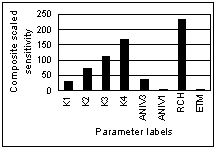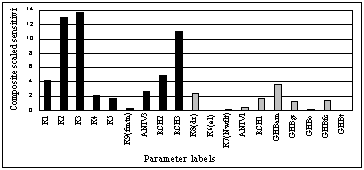Ground Water
| Mary C. Hill |
ABSTRACT
This report documents methods and guidelines for model calibration using inverse modeling. The inverse modeling and statistical methods discussed are broadly applicable, but are presented as implemented in the computer programs UCODE, a universal inverse code that can be used with any application model, and MODFLOWP, an inverse code limited to one application model. UCODE and MODFLOWP perform inverse modeling, posed as a parameter-estimation problem, by calculating parameter values that minimize a weighted least-squares objective function using nonlinear regression. Minimization is accomplished using a modified Gauss-Newton method, and prior, or direct, information on estimated parameters can be included in the regression.
Inverse modeling in many fields is plagued by problems of instability and nonuniqueness, and obtaining useful results depends on

Composite scaled sensitivities for parameters of the initial Death Valley regional ground-water flow system model of D'Agnese and others (1998, in press). K* are hydraulic-conductivity parameters, ANIV* are vertical anisotropy parameters, RCH is an areal recharge parameter, and ETM is a maximum evapotranspiration parameter. The composite scaled sensitivities indicate that the available data provide the most information about parameters K4 and RCH.

Composite scaled sensitivities for the parameters of the final calibrated Death Valley regional ground-water system model of D'Agnese and others (in press). Parameters estimated by regression have black bars; parameters defined but not estimated by regression have gray bars.
Free Download of Adobe Acrobat Reader.
| Accessibility|FOIA|Privacy|Policies and Notices | |
 |
|